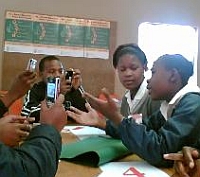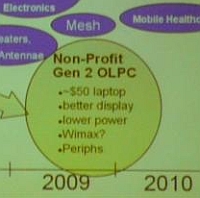The greatest downsides of the OLPC project has been said to be the total lack of piloting with research on educational impact, as well as lack of curriculum integration and implementation plan. I am Teemu Leinonen and I think these two challenges are obviously interlinked.
The reason for this can be that One Laptop Per Child does not value very high the principles of human-centered design, neither educational planning. Without these pieces in place the claim of OLPC being educational project rather than a laptop project is not very convincing.
It's not a secret that OLPC is a project of technologists, more precisely engineers. It's also known that educators design education, (good) designers design solutions and engineers design technology. We may ask what OLPC laptop is? Is it education solution or technology?
It looks that a large part the OLPC's laptop design is based on strong interpretations made out of poor or no data. During the design process of the laptop the OLPC have not reported any results from any pilots where the target group - in their real situations and context of learning - would have been testing prototypes.
The observations have been in the level of laptops being the "brightest light source in the house" and press images of happy children. These results do not convince enlightened educators or designers looking for educational solutions, but they obviously receive applauses from engineers, populist politicians and their followers.
To design a great product requires understanding reality and mindset of the people for whom you are designing for, as well as the system where the people are living. You reach this level of understanding of the people and their life only by involving them to the actual design process. In design circles this kind of process is called Participatory Design.
In Participatory Design the people using technology are recognized as the prime source of innovation. Design ideas arise in collaboration of participants with different backgrounds and expertise. This is why designers prefer to spend time with people in their everyday life situations rather than test prototypes in laboratories.
This way the problems arise from the real context where people are living. The problems are then defined and articulated in collaboration with number of stakeholders. The problems should never be attributed from the outside – neither the solution.
In OLPC, Participatory Design would have meant that the OLPC headquarters would have been located to - let say - Lagos, Nigeria. In Lagos the OLPC staff would then get in touch and involve local designers, educators, engineers, teachers and students to the design process. They would ask them to define problems in their educational landscape and come-up with ideas of how to solve them.
A design that does not match with the people's needs and the system they are living in is in a great danger to fail. People simply will not take the product in use, even if they'll get it for free. Also already existing socio-historical ecosystem may not support the product, but rather despises it. For this reason good design process is a discreet interaction with people and systems. It is interdisciplinary activity.
I love OLPC. I hope it is not too late to involve people to the design process. I also hope that there will be OLPC "tool" 2.0, a XO-2. To make sure that we are not limiting our imagination to "laptop" we probably should talk about "personal learning device" (PLD). Could we already now find people to imaging how the OLPC (or PLD) XO-2 tool could be, and how people would use it to enhance their education? Like Engadget's call for OLPC XO-1 changes last month.
I am not claiming that the OLPC laptop XO-1 will necessary fail, but it is always good to have a plan B. Especially I would like to hear ideas from the developing world. So, if you have an idea of a device and a situation where it could be used, please do the following:
- Write a script of a learning situation where some one is using your device.
- Make a "low-tech", two minutes, scenario video that shows the situations and the device.
- Post your video somewhere online and send the link to the OLPC News.
It is the first step towards OLPC XO-2. The next step is to open an office in Lagos.





"In Participatory Design the people using technology are recognized as the prime source of innovation."
I think that olpc's approach is to fill the laptop with so many different, flexible tools (including lots of programing tools) that the learning communities can then go ahead and innovate on their own and design what they need. And remember that the laptops will be connected to the web, which is a repository of thousands of oss programs and other resources.
I am reminded about something people have said about the difference between Windows and Unix. In Windows the designers spent a lot of time looking at what people do with computers, and on that basis made up a set of functions and made them easy to do. Anything that didn't fall in the set was left hard or impossible.
In Unix, in contrast, the assumption was made that there was no way to predict what people would want to do, so they made up a set of flexible, powerful tools that people could use to do just about anything. I think olpc is following something like the Unix model, the difference being that the olpc tools don't require a lot of expertise to use like the Unix tools do.
Teemu, I think you are in a place half-way in between the Windows model and the Unix model.
In Brazil, one of the two pilot project is here, at Cognitive Studies Laboratory:
http://www.lec.ufrgs.br/index.php/Projeto_UCA_-_Um_Computador_por_Aluno
The hardware, once deployed, is pretty much done. There's not much that can be done to change it, and the investment is substantial.
But for software this is certainly not the case. And clearly the laptop will not be shipped with everything necessary for a successful learning experience. I don't think the OLPC project believes it can create a full experience; part of the Constructivist educational ideals of the project is that a complete plan is neither necessary nor ideal -- it is the act of constructing that environment where much of the learning potential exists. So the emphasis is on giving children tools to create; not just programming tools, but also things like wikis, drawing programs, etc.
"I love OLPC. I hope it is not too late to involve people to the design process."
It's too late to get involved in the hardware design process. But I don't think people are that concerned about the hardware; it's a quality machine with a thoughtful design. It will never be too late to get involved in the software design process. (Sometimes it is too *early* to get involved in design processes, as designing something no one is ready to implement won't be very useful.)
"In OLPC, Participatory Design would have meant that the OLPC headquarters would have been located to - let say - Lagos, Nigeria. In Lagos the OLPC staff would then get in touch and involve local designers, educators, engineers, teachers and students to the design process."
So OLPC should have opened an office in Lagos, spent a couple of years designing hardware and software to meet Nigeria's unique needs, then moved on to, say, Cairo, spend two years there doing likewise, and after about two centuries every one of the one hundred or so developing countries would each have its own custom-designed technology. Or am I missunderstanding what you are advocating?
Eduardo Montez: "Teemu, I think you are in a place half-way in between the Windows model and the Unix model."
You are right. Windows is not really a good example of Participatory Design, but obviously Microsoft researchers and developers spend a lot of time with their users. If the usability of the OLPC will be like in Unix it will fail.
Ian Bicking: "It's too late to get involved in the hardware design process."
This is probably true with the XO, but not with the "personal learning device". I do not believe that the XO is the end of history and the last digital tool for education.
"If the usability of the OLPC will be like in Unix it will fail."
But it's not like Unix, it is much more user-friendly. For instance, programing is in Python, which is much easier to learn and read than is Unix's traditional language, C.
Teemu, I think you are making the assumption that there is one model, namely Participatory Design, that is best for all occasions. But compare the development of the internet with the development of the cpu. They followed very different models, one being open discussion and the other closed proprietary, and each were enormous successes. Olpc has so far been fabulously successful. It is not even in production yet, and it has opened up a whole new market of computers designed for the devoping world.
Teemu, if you think your model is so much better, why don't you start a project in education IT technology, and develop something much better than olpc? Instead of telling Negroponte he is going at it all wrong, how about some competition between the different models, and see which one wins?
Eduardo Montez: "But it's not like Unix, it is much more user-friendly. For instance, programming is in Python, which is much easier to learn and read than is Unix's traditional language, C."
Smalltalk, designed for children programming is shipped in the OLPC and it is much easier to learn and use than Python. Too badly, Smalltalk is deeply hidden in OLPC and people from OLPC does not want it to be used by kids. This show how few the target public, the kid, is taken in consideration.
I agree with Teemu, this is not an educative project, but a technologist project with very naive conception of education and user centred design.
Larry, I design Smalltalk computers for children but don't agree with your evaluation of OLPC.
Nearly all those involved are from a Unix background and they find the Smalltalk world different and hard to understand, so Squeak/eToys doesn't always get the attention it deserves and a lot of effort is wasted duplicating in Python stuff that has been working well in Squeak for years. But Squeak IS included! Give them a few more years to see what the children can do with each tool.
larry,
"I agree with Teemu, this is not an educative project, but a technologist project with very naive conception of education and user centred design."
My debate with Teemu is that he seems to be assuming there is one right way to develop technology, namely the one he is selling. But look for instance at the gui. Douglas Englebart didn't come up with it by spending months talking with the computer users of the day. Rather he came up with a radical new vision of how computers could be used by millions of people who were at the time not users.
I think that is true of most major technological advances. They don't result from participatory design but rather some person or group with a vision. That was true of the cpu, the personal computer, and the world wide web.
In the case of olpc, it started with Seymour Papert's vision of constuctivist education, and then Negroponte's vision of how to bring it to the developing world.
Suppose Negroponte had instead followed the participatory design method. What he would have come up with would not have been one tenth as innovative as what he and his group did by following his vision. I am not saying that participitory designe is bad. No doubt it produces excellent results in many cases. It's just that it can't do what following a vision can.
Visionaries are rare, talented people. Teemu seems to want the visionaries to give up their visions and dumb themselves down to his level. I think that is a bad idea.
A very good post. It is too late to change the hardware specs, and most of the software is already crystalizing too, and I wonder about the pedagogical basis about some of their decisions, like a view source button. But since the software is all open source, we can customize it later.
I'm a bit worried by that review by a 12 year old that said it takes minutes (not seconds) to wait for applications to start up.
Anyway it is mostly moot until we can get our hands on an XO laptop, which apparently won't be available for at least a few more months minimum. As an alternative, the Asus Eee PC 701 (based on the classmate PC) is apparently due to go on sale in September for $199 or so, and has double the specs as the OLPC, so we'll see how useful it is.
http://edtechdev.blogspot.com/2007/07/199-laptop-due-out-soon-asus-eee-pc.html
Eduardo Montez wrote:
"But look for instance at the gui. Douglas Englebart didn't come up with it by spending months talking with the computer users of the day. Rather he came up with a radical new vision of how computers could be used by millions of people who were at the time not users."
Douglas Engelbart invented the gui and the mouse and so forth, but the gui and mouse you use today have been refined over many many years. For example, drop-down menus weren't invented until the 80s by Bill Atkinson (in one night apparently). Windows didn't overlap until the first mac. And of course the mouse scroll wheel is a recent enhancement (by Microsoft) that we all use now.
And the $100 laptop itself is not entirely new of course, but based on years of us all using laptops, including students in pioneering 1-to-1 laptop programs.
Eduardo Montez : "But look for instance at the gui. Douglas Englebart didn't come up with it by spending months talking with the computer users of the day. Rather he came up with a radical new vision of how computers could be used by millions of people who were at the time not users."
I propose that you'll take another look of the way Englebart's group use to work and for whom did they do their design. I would claim that what Engelbart’s group was doing was actually "participatory design". The tools they developed were targeted for "knowledge worker" (they themselves) and the user of their system was very close to them (themselves). That is why they were so successful.
Regarding menu and overlap windows it was used in the 70's in the first implementations of Smalltalk.
Those items were also designed through "participatory design" for kids.
The "show source" feature was also implemented in Smalltalk with the idea to expose user/kids to source code, but it is greatly superior to the silly "show python source code" button in OLPC. Indeed in this 30 years old Smalltalk design of the show source code feature, not only kids can view source code but *more* interesting can change the code of running code.
This is silly OLPC fails to capture this 30 years olds advanced features, carefully designed and developed in participatory design mode.
For some more insights:
http://gagne.homedns.org/%7etgagne/contrib/EarlyHistoryST.html